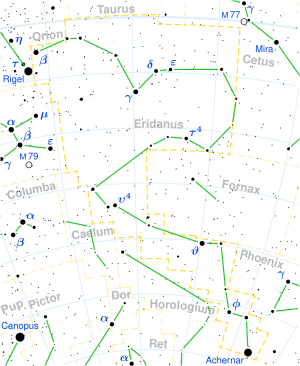Location of DENIS 0255−4700 in the constellation Eridanus | |
| Observation data Epoch J2000 Equinox J2000 | |
|---|---|
| Constellation | Eridanus |
| Right ascension | 02h 55m 03.693s[1] |
| Declination | −47° 00′ 51.36″[1] |
| Characteristics | |
| Spectral type | L8/L9[2] |
| Apparent magnitude (V) | ~22.9[3] |
| Apparent magnitude (R) | ~20.1[3] |
| Apparent magnitude (I) | ~17.2[3] |
| Apparent magnitude (J) | ~13.2[3] |
| Astrometry | |
| Proper motion (μ) | RA: 1,012.445 mas/yr[1] Dec.: −554.031 mas/yr[1] |
| Parallax (π) | 205.4251 ± 0.1857 mas[1] |
| Distance | 15.88 ± 0.01 ly (4.868 ± 0.004 pc) |
| Absolute magnitude (MV) | 24.44 |
| Details | |
| Mass | 0.025–0.065[2] M☉ |
| Radius | 0.08–0.1[2] R☉ |
| Luminosity | 0.0000154[4] L☉ |
| Temperature | ~1300[2] K |
| Rotation | 1.7 hours[5] |
| Rotational velocity (v sin i) | 40.8±8.0[5] km/s |
| Age | 0.3–10[2] Gyr |
| Other designations | |
| Database references | |
| SIMBAD | data |
DENIS 0255−4700 is an extremely faint brown dwarf 15.9 light-years (4.9 parsecs) from the Solar System in the southern constellation of Eridanus.[3][7] It is the closest isolated L-type brown dwarf (no undiscovered L-dwarfs are expected to be closer), and only after the binary Luhman 16. It is also the faintest brown dwarf (with the absolute magnitude of MV=24.44) having measured visible magnitude.[8] A number of nearer T and Y-type dwarfs are known, specifically WISE 0855−0714, Epsilon Indi B and C, SCR 1845-6357 B, and UGPS 0722−05.
History of observations
DENIS 0255−4700 was identified for the first time as a probable nearby object in 1999.[7] Its proximity to the Solar System was established by the RECONS group in 2006 when its trigonometric parallax was measured.[8] DENIS 0255-4700 has a relatively small tangential velocity of 27.0 ± 0.5 km/s.[2]
Properties
The photospheric temperature of DENIS 0255−4700 is estimated at 1300 K.[2] Its atmosphere in addition to hydrogen and helium contains water vapor, methane and possibly ammonia.[9] The mass of DENIS 0255−4700 lies in the range from 25 to 65 Jupiter masses corresponding to the age range from 0.3 to 10 billion years.[2] The brown dwarf is rotating rapidly with the period of 1.7 hours, and its rotational axis is inclined 40 degrees from the line-of-sight.[5]
See also
References
- ^ a b c d Vallenari, A.; et al. (Gaia collaboration) (2023). "Gaia Data Release 3. Summary of the content and survey properties". Astronomy and Astrophysics. 674: A1. arXiv:2208.00211. Bibcode:2023A&A...674A...1G. doi:10.1051/0004-6361/202243940. S2CID 244398875. Gaia DR3 record for this source at VizieR.
- ^ a b c d e f g h Stephens, Denise C.; Leggett, Sandy K.; Cushing, Michael C.; Marley, Mark S.; Saumon, Didier; Geballe, Thomas R.; Golimowski, David A.; Fan, Xiaohui; Noll, Keith S. (2009). "The 0.8–14.5 μm Spectra of Mid-L to Mid-T Dwarfs: Diagnostics of Effective Temperature, Grain Sedimentation, Gas Transport, and Surface Gravity". The Astrophysical Journal. 702 (1): 154–170. arXiv:0906.2991. Bibcode:2009ApJ...702..154S. doi:10.1088/0004-637X/702/1/154. S2CID 118650774.
- ^ a b c d e "2MUCD 10158 – Brown Dwarf (M<0.08 M☉)". Centre de données astronomiques de Strasbourg. Retrieved 2009-12-14.
- ^ CARMENES input catalogue of M dwarfs V. Luminosities, colours, and spectral energy distributions
- ^ a b c Zapatero Osorio, M. R.; Martin, E. L.; Bouy, H.; Tata, R.; Deshpande, R.; Wainscoat, R. J. (2006), "Spectroscopic Rotational Velocities of Brown Dwarfs", The Astrophysical Journal, 647 (2): 1405–1412, arXiv:astro-ph/0603194, Bibcode:2006ApJ...647.1405Z, doi:10.1086/505484, S2CID 14358043
- ^ Golovin, Alex; Reffert, Sabine; Just, Andreas; Jordan, Stefan; Vani, Akash; Jahreiß, Hartmut (November 2022). "The Fifth Catalogue of Nearby Stars (CNS5)". Astronomy & Astrophysics. 670: A19. arXiv:2211.01449. Bibcode:2023A&A...670A..19G. doi:10.1051/0004-6361/202244250. S2CID 253264922. Catalogue can be accessed here.
- ^ a b "Discovery of the Nearest L Dwarf: the Intrinsically Faintest Object at Visual Wavelengths Known Beyond our Solar System". RECONS. Retrieved 2007-06-17.
- ^ a b Costa, E.; Méndez, R. A.; Jao, W. -C.; Henry, T. J.; Subasavage, J. P.; Ianna, P. A. (2006). "The Solar Neighborhood. XVI. Parallaxes from CTIOPI: Final Results from the 1.5 m Telescope Program". The Astronomical Journal. 132 (3): 1234. Bibcode:2006AJ....132.1234C. CiteSeerX 10.1.1.622.2310. doi:10.1086/505706. S2CID 18952940.
- ^ Cushing, Michael C. (2006). "Spitzer Space Telescope Observations of M, L, and T Dwarfs". ASP Conference Series. 357: 66–67. Bibcode:2006ASPC..357...66C.

